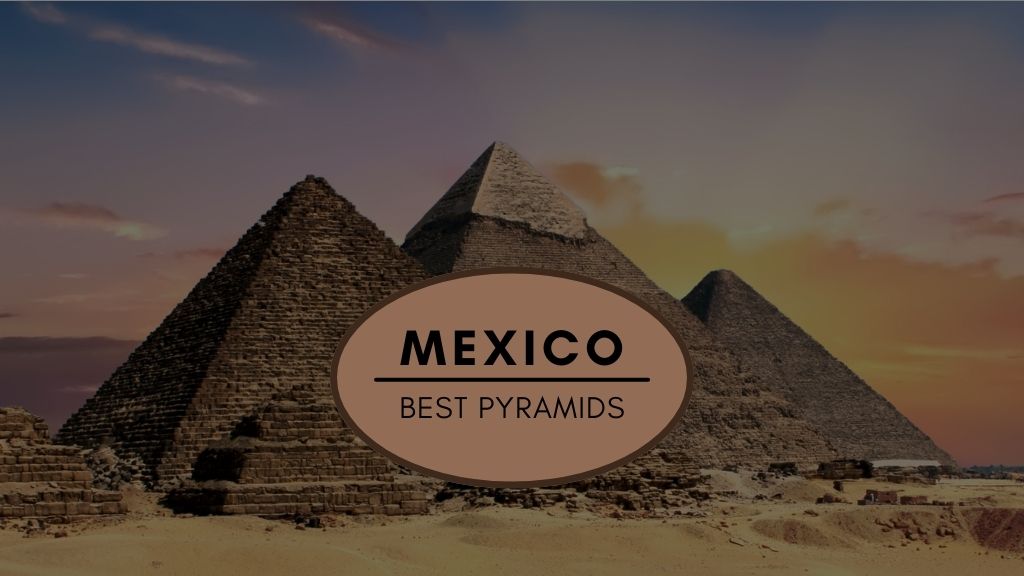Mexico is much more than just sunny beaches and festive celebrations, it is a true representation of history and culture. Among its diverse treasures are the magnificent pyramids in Mexico to visit, rivaling those of Egypt in grandeur and historical significance. These age-old structures, nestled amidst the Mexican landscape, beckon travelers and history enthusiasts alike, offering a chance to step back in time and delve deep into a rich pre-Hispanic past.
You must be thinking, where are pyramids located in Mexico? Pyramids in Mexico are scattered throughout the country, with prominent ones located in Teotihuacan, Chichen Itza, and Palenque.
The Historical Importance of Mexican Pyramids
Diving into the historical significance of Mexico’s pyramids is like embarking on a journey through time, crossing generations, and revisiting the echoes of ancient chants and ceremonies. These monumental structures are more than just stone constructions; they narrate tales of civilizations, beliefs, and innovations that once flourished in the region.
Many people think: Are the pyramids in Mexico older than Egypt? The answer is no, the pyramids in Egypt are older than those in Mexico. Let’s explore more about the history of the Mexican pyramids!
Journey with the Pre-Hispanic Civilizations
Long before European feet touched the American continent, Mexico was home to vibrant and advanced societies. Among these, the Mayans and Aztecs stand out not just for their sprawling empires but also for their architectural and astronomical genius.
The Mayans, with their profound understanding of celestial bodies, constructed pyramids aligned with the stars and planetary movements. The Temple of Kukulkan in Chichen Itza, for instance, is renowned for its shadow play during equinoxes, manifesting the descending serpentine deity.
The Aztecs, on the other hand, built the colossal Templo Mayor in the heart of their capital, Tenochtitlan. This structure, dedicated to the gods of war and rain, symbolized the very core of Aztec religious and political power. The pyramids were more than just buildings; they were sites for ceremonies, sacrifices, and celebrations, echoing the rhythms of life, death, and rebirth.
Mesoamerican Culture: A Deep Dive
The pyramids stand as lasting monuments to the sophistication and depth of Mesoamerican culture. Every step, every stone, and every carving narrates a story. From depictions of gods and goddesses to intricate glyphs that recorded historical events, the pyramids were, in many ways, vast canvases where the essence of an entire civilization was portrayed.
The attention to detail is evident in the precision of the structures, where mathematical acumen met the artistic vision. The orientation of the pyramids, their layout, and their very design often encapsulated the Mesoamericans’ understanding of the cosmos, their environment, and their place within it.
Furthermore, these pyramids are testimonies to the societal hierarchies, religious beliefs, and daily lives of the people. The very act of constructing these grand edifices required a collective effort, showcasing the society’s organization, from the rulers and priests to the common populace.
Now that we have explored the historic significance of pyramids, let’s have a look at the most amazing pyramids near Mexico that you must at to your visiting list:
1) Pyramid of the Sun
One of the most iconic and colossal structures in Teotihuacan, the Pyramid of the Sun stands 225 feet tall, making it the third-largest pyramid in the world. Its exact purpose remains a mystery, but researchers believe it was used for religious and astronomical purposes. As you ascend its steps, you can almost feel the weight of centuries of rituals and ceremonies. Beneath this behemoth lies a cave, further deepening its enigma and its spiritual significance.
2) Pyramid of the Moon
Situated at the northern end of the ‘Street of the Dead’, the Pyramid of the Moon complements the Pyramid of the Sun. While smaller in size, it’s equally significant in terms of cultural importance. The pyramid was possibly dedicated to the Great Goddess of Teotihuacan, a deity of water, fertility, and the Earth. With its numerous platforms, the pyramid represents the stages of life, a testament to the cyclical nature of existence as viewed by its ancient builders.
3) El Castillo (Temple of Kukulkan)
Located in Chichen Itza, El Castillo, also known as the Temple of Kukulkan, is a marvel of both architecture and astronomy. This 98-foot-tall pyramid has 365 steps – one for each day of the year. During the spring and autumn equinoxes, a unique play of light and shadow creates the illusion of a serpent descending the pyramid’s staircase, showcasing the Mayans’ deep understanding of astronomy and their penchant for integrating it into their architecture.
4) Coba Pyramids
Coba, deep within the Yucatan Peninsula, is a vast ruined city with several large temple pyramids. The largest, Nohoch Mul, stands 138 feet tall and is one of the few that visitors can still climb. From its summit, you can witness a breathtaking view of the thick jungle canopy below, transporting you back in time.
5) Calakmul Pyramid
Calakmul is one of the largest ancient Mayan cities ever uncovered, and its main pyramid is one of the largest Mayan structures still in existence. Located in the remote biosphere reserve near the Guatemala border, the pyramid offers a peek into the power and influence Calakmul wielded during its peak. With over 6,000 ancient structures identified in this region, it’s a paradise for history enthusiasts.
6) El Tajín
Located in the state of Veracruz, El Tajín was one of the largest and most influential cities during the Classic era of Mesoamerica. The city is home to the famous Pyramid of the Niches, a six-tiered structure adorned with 365 square niches – possibly representing the solar year. The pyramid, with its unique architectural style, showcases the advanced understanding of both calendar systems and the aesthetics of its constructors.
7) Temple of the Inscriptions, Palenque
This pyramid in Palenque is not the tallest, but it’s undoubtedly one of the most significant. It gets its name from the intricate inscriptions found inside. The primary attraction is the tomb of Pakal the Great, one of the most famous Maya rulers. Discovered in 1952, his sarcophagus, with its elaborately carved lid, led to numerous debates and theories about Mayan connections to extraterrestrial life.
8) La Venta’s Great Pyramid
Situated in the humid lowlands of Tabasco, the Olmec city of La Venta houses a unique pyramid. Unlike the others made of stone, this one is entirely constructed from clay and earth. The significance? It’s among the earliest pyramid constructions in ancient Mesoamerica, marking the start of the pyramid-building tradition.
9) The Pyramid of the Magician, Uxmal
With its oval base, the Pyramid of the Magician (or Adivino) stands out from the typically rectangular or square pyramid bases. Found in Uxmal, a UNESCO World Heritage site, local legends claim the structure was built overnight by a dwarf magician. With its steep sides and distinctive rounded corners, this pyramid is an embodiment of the Puuc architectural style and a reflection of the region’s mythology and folklore.
10) Temple of the Feathered Serpent, Teotihuacan
This temple, also known as the Temple of Quetzalcoatl, is smaller compared to the pyramids of the Sun and Moon in Teotihuacan but is highly significant. Adorned with intricate carvings of the feathered serpent deity, Quetzalcoatl, this edifice showcases the advanced sculptural techniques of its builders. Recent discoveries of tunnels and chambers beneath the structure hint at its potential role in rituals and as a burial site.
The Significance of Mexican Pyramids in Modern Times
In a rapidly advancing world, one might wonder about the relevance of ancient pyramids. However, these age-old edifices are not mere remnants of the past; they are deeply intertwined with modern times, showcasing significance in various facets of today’s society.
1) Cultural Identity and National Pride
The pyramids stand as testaments to Mexico’s rich pre-Columbian history. They remind Mexicans of their roots, giving them a sense of identity and continuity. Every stone and artifact tells tales of civilizations that once flourished, making the pyramids pivotal in binding the present with the past. They are emblematic symbols, anchoring national pride and serving as a reminder of the country’s glorious heritage.
2) Boosting Tourism and Economy
Tourism plays a crucial role in Mexico’s economy, and these pyramids act as major attractions. Every year, millions of tourists, history enthusiasts, and researchers flock to these sites, contributing substantially to the local economy. The revenue generated helps maintain these historic sites, funds further archaeological research, and aids in boosting the local businesses surrounding these attractions.
If you are planning to Explore both Cancun and the pyramids then you may think how far is Cancun from the famous pyramids? Well, Cancun is roughly 200 km (about a 2-hour drive) from the famous pyramids at Chichen Itza. So, this makes the pyramids an excellent tourist attraction! This is a good marriage and honeymoon destination too! You can book a private yacht for wedding at H2OH to make the best out of the experience and explore the amazing pyramids!
3) Education and Research
The pyramids are goldmines for historians, archaeologists, and students. They offer invaluable insights into ancient Mesoamerican societies, their religious beliefs, social structures, and architectural prowess. Institutions worldwide often collaborate for excavations, bringing international attention and fostering academic relationships.
4) Architectural Inspiration
Modern architects and designers often draw inspiration from the pyramids’ structural brilliance and aesthetics. The techniques employed, the precision, and the materials used serve as study materials for sustainable and resilient construction. The blend of functionality and artistry in these pyramids is a lesson in creating lasting impressions.
5) Cultural Preservation and UNESCO
Many pyramid sites, given their historical importance, are recognized as UNESCO World Heritage Sites. This designation ensures that they receive the necessary protection and conservation. In an age where urbanization is rampant, such recognition ensures that these sites are preserved for future generations.
6) Spiritual and Mystical Allure
Beyond the tangible, the pyramids also hold spiritual significance. Many people visit these sites not just for their historical appeal but for a deeper, mystical experience. The energy, the legends, and the aura surrounding these pyramids often provide spiritual seekers with a sense of connection and transcendence.
Wrapping Up
In the heart of Mexico, where the past intertwines seamlessly with the present, the pyramids stand as silent witnesses to millennia of history, innovation, and culture. Each stone and carving tells a tale, waiting for the curious soul to listen. To visit these pyramids is to embrace an essential part of Mexico’s soul, understanding not just its history but its undying spirit that continues to inspire generations. Whether you’re a traveler, a history buff, or someone seeking a deeper connection, these must-visit pyramids in Mexico promise a journey unlike any other.
Book a boat rental Akumal at H2OH make the best out of your trip to the pyramids of Mexico!








